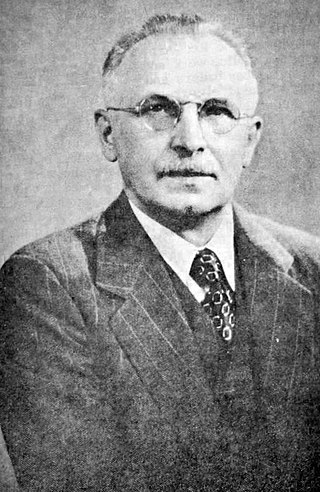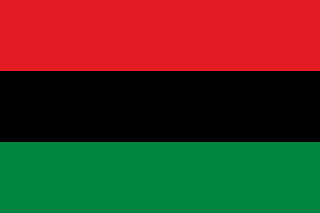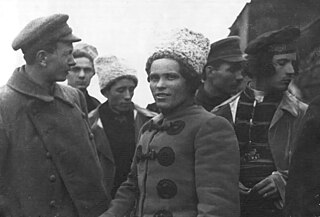Anarchism in Latvia emerged from the Latvian National Awakening and saw its apex during the 1905 Russian Revolution. Eventually the Latvian anarchist movement was suppressed by a series of authoritarian regimes in the country.
| Part of a series on |
| Anarchism |
|---|
 |
Anarchism in Latvia emerged from the Latvian National Awakening and saw its apex during the 1905 Russian Revolution. Eventually the Latvian anarchist movement was suppressed by a series of authoritarian regimes in the country.
During the time of the Livonian Confederation, peasants retained personal freedom and self-government, [1] but after the Livonian War the power of landowners was expanded, culminating in the establishment of the Duchies of Livonia, Courland and Semigallia under the Polish–Lithuanian Commonwealth, when the peasant class was brought into serfdom. When Livonia was brought under the rule of the Swedish Empire, the abolition of serfdom was briefly proposed, but it was rejected by the region's ruling Baltic German nobility, which desired to retain ownership of the peasants. [2]
After the end of the Great Northern War in 1721, the Baltic region was brought under the rule of the Russian Empire, but the peasants continued to be administered by the Baltic German nobility under a feudal Landtag. [3] Serfdom was subsequently expanded under Catherine the Great, [4] after the defeat of Pugachev's Rebellion. [5] In response, local voices such as Johann Georg Eisen von Schwarzenberg [6] and Garlieb Merkel [7] began to advocate for the abolition of serfdom. [8]
After the suppression of the Kauguri riots in 1802, new peasant laws were introduced that replaced serfdom with villeinage, which tied peasants to the land rather than directly to the land-owners. [9] This was followed by the complete abolition of serfdom throughout most of the Baltic by 1820, [10] preceding the Emancipation reform of 1861 which abolitioned serfdom throughout the entirety of the Russian Empire.
Around this time the First Latvian National Awakening was taking place, during which the Young Latvians began to advocate for a romantic nationalism, [11] in opposition to the remnants of feudalism retained by the Baltic German nobility. In the 1880s, the New Current movement emerged from the national awakening, taking a more explicitly political approach, inspired by the socialist ideas of the time. Socialism was particularly appealing to the hundreds of thousands of landless peasants in Latvia, as well as the country's growing urban proletariat.
At the turn of the 20th century, the working classes of the Baltic states began to wage an open struggle against the Russian Empire. Latvian landless peasants began to seize vacant land for themselves, beginning a period of peasant uprisings. When these uprisings were repressed by the landowners, many peasants fled into the woods where they formed partisan detachments known as the "Forest Brothers" and organized to attack wealthy estates and local police. Participation in the detachments was voluntary, with decisions being made by consensus, without organizational hierarchy. [12] [13]
In the wake of Bloody Sunday, a general strike was called in Riga, beginning the 1905 Revolution in Latvia, as Latvian workers began to revolt against both the Russian authorities and German nobility. [14] Anarchist ideas began to spread throughout the Latvian working classes, with the first anarchist groups being established throughout the country, largely led by Latvian Jews. An anarcho-communist group known as the Riga International [15] began to conduct propaganda work among the poor in both the Yiddish and Latvian languages, even translating The Conquest of Bread by Peter Kropotkin into Latvian. Eventually, a number of disparate anarchist groups throughout the Latvian capital united together, establishing the Federation of Riga Anarchist Communist Groups. [12]
By the autumn of 1905, armed conflict between the German nobility and the Latvian peasants began in the rural areas of Vidzeme and Courland. In Courland, the peasants seized or surrounded several towns where they established revolutionary councils. In Vidzeme the fighters took control of the Rūjiena-Pärnu railway line. Altogether, a thousand armed clashes were registered in Latvia in 1905. [16] Anarchists joined in the armed struggle, launching a number of attacks against the forces of the German nationalist paramilitary forces, as well as the property of the Latvian capitalist class. [12]
In response, the Russian Empire declared martial law and began to violently suppress the Latvian revolutionary movement, which anarchists led armed resistance against. In the ensuing repression, many anarchists were arrested and sentenced to hard labor or prison, while a number of young Jewish anarchists were sentenced to death by a military tribunal. [12] In total, hundreds of people were executed, many without trial, while thousands more were sent into exile in Siberia or fled to Western Europe. Latvian anarchists that had fled to London continued their revolutionary activities, taking part in a number of bank robberies that culminated in the events of the Tottenham Outrage and the Siege of Sidney Street. [17]
In Latvia, the anarchist movement was forced by the repression to change its tactics, with many aligning themselves with anarcho-syndicalism. Towards the end of 1907, the Free Workers' Organisation was established in Riga, and its members became known as the Yankovists, after the group's founder. The Yankovists began to organize among the working classes, advocating open class conflict through strikes, expropriations and property destruction. Former social democrats of the Latvian Social Democratic Union and the Social Democracy of the Latvian Territory began to join the Free Workers' Organisation, disillusioned by party politics. However, by September 1908, the organisation was dissolved, as many Yankovists disseminated themselves into legal trade unions. [12]
Following the February Revolution, Latvian revolutionaries began to return to the country, including a number of anarchists. In August 1917, the Liesma group was founded along anarcho-syndicalist lines and went on to actively participate in the October Revolution. After committing some expropriations, the group established the Latvian Anarchists' Club in a small house, which held reading circles and lectures. When faced with the need to begin publishing anarchist literature, the group occupied a larger house and renovated its previous property into a housing cooperative. The group also founded a unit of Black Guards to fight against counter-revolutionary elements. In April 1918, a number of Latvians arrived from Kharkov and joined the Liesma group, which went on to occupy a manor house, open a museum and establish the Latvian Anarchist Theatre. However, their house was soon after raided by the Red Army and the anarchists were arrested, taken to Butyrka prison and tortured. The group was later released, recognized as "ideological revolutionaries", but only after their work had been thoroughly destroyed. [18]
After the Latvian victory over the Bolsheviks in the Latvian War of Independence, the new Republic of Latvia was constituted as a liberal democracy. But the 1934 Latvian coup d'état established an authoritarian regime under Kārlis Ulmanis, which suppressed the country's left-wing opposition. The subsequent Soviet occupation in 1940, Nazi occupation in 1941 and Soviet re-occupation in 1944 ensured the ultimate suppression of any remaining left-wing opposition. The Latvian Soviet Socialist Republic was established under the single-party rule of the Communist Party of Latvia. The country eventually regained its independence during the Singing Revolution, which restored liberal democracy after over 50 years of authoritarian rule.
The anarchist movement slowly began to re-emerge during the 21st century, with a group of Latvian anarchists going on to participate in the 2012 Baltic Anarchist Meeting. [19]

The history of Latvia began around 9000 BC with the end of the last glacial period in northern Europe. Ancient Baltic peoples arrived in the area during the second millennium BC, and four distinct tribal realms in Latvia's territory were identifiable towards the end of the first millennium AD. Latvia's principal river Daugava, was at the head of an important trade route from the Baltic region through Russia into southern Europe and the Middle East that was used by the Vikings and later Nordic and German traders.
Anarchist communism is a far-left political ideology and anarchist school of thought that advocates communism. It calls for the abolition of private property but retention of personal property and collectively-owned items, goods, and services. It supports social ownership of property and the distribution of resources.
Anarcho-syndicalism is an anarchist organisational model that centres trade unions as a vehicle for class conflict. Drawing from the theory of libertarian socialism and the practice of syndicalism, anarcho-syndicalism sees trade unions as both a means to achieve immediate improvements to working conditions and to build towards a social revolution in the form of a general strike, with the ultimate aim of abolishing the state and capitalism. Anarcho-syndicalists consider trade unions to be the prefiguration of a post-capitalist society and seek to use them in order to establish workers' control of production and distribution. An anti-political ideology, anarcho-syndicalism rejects political parties and participation in parliamentary politics, considering them to be a corrupting influence on the labour movement. In order to achieve their material and economic goals, anarcho-syndicalists instead practice direct action in the form of strike actions, boycotts and sabotage. Anarcho-syndicalists also attempt to build solidarity among the working class, in order to unite workers against the exploitation of labour and build workers' self-management.

Baltic Germans are ethnic German inhabitants of the eastern shores of the Baltic Sea, in what today are Estonia and Latvia. Since their resettlement in 1945 after the end of World War II, Baltic Germans have markedly declined as a geographically determined ethnic group in the region.
Anarcho-pacifism, also referred to as anarchist pacifism and pacifist anarchism, is an anarchist school of thought that advocates for the use of peaceful, non-violent forms of resistance in the struggle for social change. Anarcho-pacifism rejects the principle of violence which is seen as a form of power and therefore as contradictory to key anarchist ideals such as the rejection of hierarchy and dominance. Many anarcho-pacifists are also Christian anarchists, who reject war and the use of violence.

Anarchism in the United Kingdom initially developed within the religious dissent movement that began after the Protestant Reformation. Anarchism was first seen among the radical republican elements of the English Civil War and following the Stuart Restoration grew within the fringes of radical Whiggery. The Whig politician Edmund Burke was the first to expound anarchist ideas, which developed as a tendency that influenced the political philosophy of William Godwin, who became the first modern proponent of anarchism with the release of his 1793 book Enquiry Concerning Political Justice.

Grigorii Petrovich Maksimov was a Russian anarcho-syndicalist. From the first days of the Russian Revolution, he played a leading role in the country's syndicalist movement – editing the newspaper Golos Truda and organising the formation of factory committees. Following the October Revolution, he came into conflict with the Bolsheviks, who he fiercely criticised for their authoritarian and centralist tendencies. For his anti-Bolshevik activities, he was eventually arrested and imprisoned, before finally being deported from the country. In exile, he continued to lead the anarcho-syndicalist movement, spearheading the establishment of the International Workers' Association (IWA), of which he was a member until his death.
According to different scholars, the history of anarchism either goes back to ancient and prehistoric ideologies and social structures, or begins in the 19th century as a formal movement. As scholars and anarchist philosophers have held a range of views on what anarchism means, it is difficult to outline its history unambiguously. Some feel anarchism is a distinct, well-defined movement stemming from 19th-century class conflict, while others identify anarchist traits long before the earliest civilisations existed.

Anarchism in Africa refers both to purported anarchic political organisation of some traditional African societies and to modern anarchist movements in Africa.

Black anarchism, also known as New Afrikan anarchism or Panther anarchism, is an anti-authoritarian and anti-racist current of the Black power movement and anarchism in the United States. It is characterized by its intersectional analysis of different forms of oppression, its skepticism of both authoritarian socialism and Eurocentric anarchism, and its advocacy of community organizing, armed self-defense and revolutionary black nationalism.
Anarchism in China was a strong intellectual force in the reform and revolutionary movements in the early 20th century. In the years before and just after the overthrow of the Qing dynasty Chinese anarchists insisted that a true revolution could not be political, replacing one government with another, but had to overthrow traditional culture and create new social practices, especially in the family. "Anarchism" was translated into Chinese as 無政府主義 literally, "the doctrine of no government."

Anarchism in Ukraine has its roots in the democratic and egalitarian organization of the Zaporozhian Cossacks, who inhabited the region up until the 18th century. Philosophical anarchism first emerged from the radical movement during the Ukrainian national revival, finding a literary expression in the works of Mykhailo Drahomanov, who was himself inspired by the libertarian socialism of Pierre-Joseph Proudhon. The spread of populist ideas by the Narodniks also lay the groundwork for the adoption of anarchism by Ukraine's working classes, gaining notable circulation in the Jewish communities of the Pale of Settlement.
Anarchism in Russia developed out of the populist and nihilist movements' dissatisfaction with the government reforms of the time.

Anarchism in Poland first developed at the turn of the 20th century under the influence of anarchist ideas from Western Europe and from Russia.
Collectivist anarchism, also called anarchist collectivism and anarcho-collectivism, is an anarchist school of thought that advocates the abolition of both the state and private ownership of the means of production. In their place, it envisions both the collective ownership of the means of production and the entitlement of workers to the fruits of their own labour, which would be ensured by a societal pact between individuals and collectives. Collectivists considered trade unions to be the means through which to bring about collectivism through a social revolution, where they would form the nucleus for a post-capitalist society.

Anarchism in Georgia began to emerge during the late 19th century out of the Georgian national liberation movement and the Russian nihilist movement. It reached its apex during the 1905 Russian Revolution, after a number of anarchists returned from exile to participate in revolutionary activities, such as in the newly-established Gurian Republic.
Livonian Peasants' Laws were laws introduced in the 19th century for Governorate of Livonia of the Russian Empire. About the same time similar laws has been enacted in all Baltic governorates and Duchy of Courland and Semigallia. These laws changed and clarified peasants rights and obligations, who ethnically were mainly Estonians and Latvians. This development culminated in Peasant Community Code of 1866 which codified peasants self-governance.
Anarchism in Hungary emerged from the social democratic movement in the late 19th century, coming to play a prominent role in the anti-militarist movement during World War I and in the subsequent revolution that culminated in the Hungarian Soviet Republic. The anarchist movement was then repressed by the Horthy regime, before re-emerging as part of the anti-fascist resistance movement during World War II. This second wave of anarchism was also repressed, this time by the newly established communist regime. Anarchist ideas were briefly expressed during the Hungarian Revolution of 1956 but remained largely suppressed until the fall of socialism, which gave way to a third wave of anarchism in Hungary.
Anarchism in Austria first developed from the anarchist segments of the International Workingmen's Association (IWA), eventually growing into a nationwide anarcho-syndicalist movement that reached its height during the 1920s. Following the institution of fascism in Austria and the subsequent war, the anarchist movement was slow to recover, eventually reconstituting anarcho-syndicalism by the 1990s.
Anarchism in Iran has its roots in a number of dissident religious philosophies, as well as in the development of anti-authoritarian poetry throughout the rule of various imperial dynasties over the country. In the modern era, anarchism came to Iran during the late 19th century and rose to prominence in the wake of the Constitutional Revolution, with anarchists becoming leading members of the Jungle Movement that established the Persian Socialist Soviet Republic in Gilan.